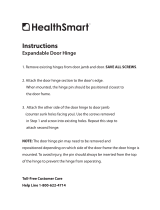
10/01/18
Installation Instructions
for Interior Door Slabs (JII110)
2
SAFETY
|
STORAGE AND HANDLING
|
FINISHING
Safety
• Read and fully understand ALL manufacturer’s instructions before
beginning. Failure to follow proper installation instructions may result in
the denial of warranty claims for operational or performanceproblems.
• Use safe lifting techniques.
• Wear protective gear (e.g. safety glasses, gloves, ear protection, etc.).
• Operate hand/power tools safely and follow manufacturer’s
operatinginstructions.
• Heed material manufacturer’s handling and application instructions.
• If disturbing existing paint, take proper precautions if lead paint is
suspected (commonly used before 1979). Your regional EPA (www.
epa.gov/lead) or Consumer Product Safety Commission ofces provide
information regarding regulations and lead protection.
WARNING: Drilling, sawing, sanding or machining wood products
can expose you to wood dust, a substance known to the State
of California to cause cancer. Avoid inhaling wood dust or use a
dust mask or other safeguards for personal protection. For more
information go to www.P65Warnings.ca.gov/wood.
Storage and Handling
• Deliver doors to the building site after the plaster, drywall and/or
concrete are dry.
• If the doors are being stored at the job site and not for immediate
installation, the top, bottom and sides must be sealed.
• Hollow core doors may be more prone to warp than solid core doors.
When stacking doors, keep the top door covered at all times with a
cover sheet, plywood or cardboard. This is critical to prevent warping.
• Keep the doors away from direct sunlight and sources of extreme heat,
cold or humidity.
• Store at on a level surface in a clean, dry, well ventilated building.
Protect from dirt, water and abuse. Allow air circulation. Cover the top
door with a moisture barrier. Do not lean the doors vertically against a
wall or other structure.
• Doors should always be handled with clean hands or while wearing
clean gloves.
• Doors should be lifted and carried when being moved, not dragged
across one another.
• Doors should not be subjected to abnormal or sudden variations in
heat, dryness or humidity, and should not be exposed to direct sunlight.
Recommended humidity and temperature are 25% - 55% RH and
50°F- 90°F (10°C - 32°C).
• Doors should be stored at least 10' away from any heat source.
Excessive heat on a door creates uneven drying which results in
warping, splitting, and bowing on the door surfaces.
• Doors should be climatized to the average prevailing humidity and
temperature before hanging for at least 48 hours. In below-zero or
extreme temperatures, doors should be stored properly in a dry building
at normal room temperatures for at least 72 hours before hanging.
Finishing
• Set-up your nishing area by making sure your work area is clean, well-
lighted, dust free, well ventilated, out of direct sunlight and in a climate
controlled environment. When painting and staining avoid carpeted
areas, cover all areas subject to paint or stain exposure.
• Doors should acclimate to the environment where they will be installed
for a minimum of 48 hours under normal room temperature conditions
(72 Hours in extreme weather conditions). Avoid nishing immediately
after a rain or damp weather and during periods of higher than average
humidity. In very dry conditions, the door should be nished right after
the wrapping is removed. Ensure adequate air ow around all surfaces
of the door when conditioning. Follow paint/stain manufacturer’s
instructions noting both temperature and humidity recommendations.
Remove all hardware before nishing.
• If you must use a water-based paint please apply in light coats,
in a warm dry environment. Do NOT reduce paint beyond the
manufacturer’s recommendations. If you attempt to apply water-based
paints in a cold or damp environment, or apply the paint in a heavy
coat, the paint will take longer to dry and the water in the paint will
penetrate into the board, raising the grain or bers in the substrate. The
use of satin or semi-gloss nish is highly recommended.
• WARNING: Distortions such as warping, bowing and waviness, can
appear as a result of incorrect topcoat (paints or stains), improper
nishing techniques and or nishing conditions. These are caused by
but are not limited to incorrect topcoat, watered down paints, high
humidity environments, excessive application of paints, and doors not
being acclimated properly.
For additional details reference Window & Door Manufacturers
Association guidelines on how to store, handle, nish and install
wood doors.









